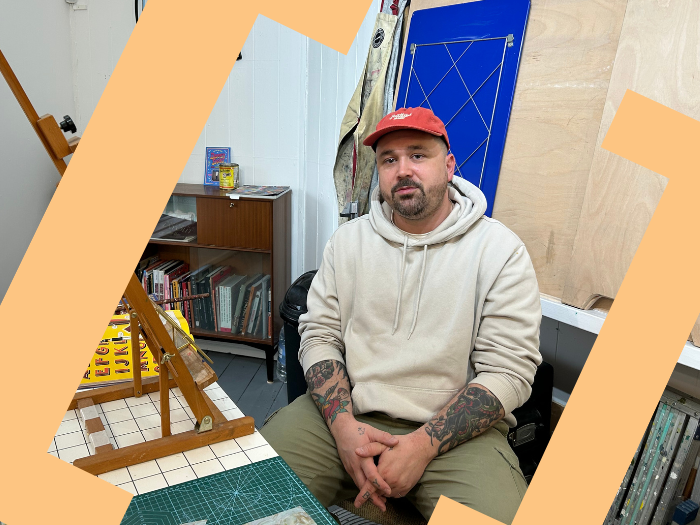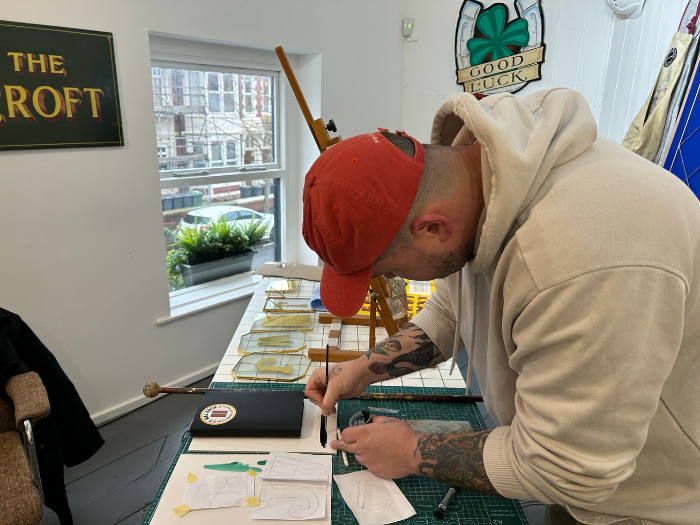
Tell us about yourself and your creative background
I was born in Carmarthen to my mother who's a ceramicist, and my dad was a musician, so I had no choice but to be creative!
I leant more towards music growing up. I was in some bands on the drums, but I could see that it wasn’t going to be a career so when I went off to university, I decided I was going to study graphics. During my degree, I started hand drawing lettering and quickly noticed that there were rules to drawing typography and became obsessed with trying to learn them.
I moved to Bristol after university and I started working in bars and restaurants and the bar owners would sort of ask me, “Oh, you can draw, can you do a sign on the back door?” or “Can you write our menu on this chalkboard?” so I started doing that. It got to the point where I was getting so much of that work that I was having to constantly ask if I could have more time off work!
it was about that time that I was researching signs and sign writing and realised that sign writing was a craft, that you could do it with brushes, using a proper technique. I found another sign designer in Bristol, the late James Cooper, who owned a company called Dapper Signs. I met him and watched him paint with a brush and it was like watching magic. As soon as I saw that, I knew it was what I wanted to do, and I’ve been doing it ever since.
What is your Creative First?
My Creative First is moving into teaching my craft through workshops. It’s such an important aspect of what I do as it was people teaching me that led me to follow this career in the first place. In this industry, people are so open, so I felt that I was never going to be guarded about teaching people things. If people want to learn, my door is always open.
Teaching was never something I saw myself doing, but after leading a workshop for kids at my daughter’s school and showing them that they can have a viable career doing what I do, it felt so important. I also worked with Cardiff Youth Justice Service on a mural and it was brilliant to see the young people get so invested and interested in what I do for work.
I would not have this job had people not been open to teaching me so it’s important to me that I do the same for future sign writers.

What was the biggest challenge you faced?
I think my job as a whole is a challenge, but I like a challenge! Essentially, what I do is problem-solve for my clients and the businesses I work with. I work with them to come up with a solution, working on their outside visuals, their menus and any graphics they use. I look at shopfronts and signage and essentially help them with the look and feel of their businesses.
One particularly challenging example involved a popular burger restaurant in Hammersmith. We decided to paint a substantial mural at the side of the building, and this involved closing an entire street in a busy part of the city. It wasn’t straightforward and involved negotiating with the council. Sometimes you have to jump through hoops, but perseverance is a key part of my job.
Can you share tips for others who might be interested in your industry?
- Perseverance and passion are key: You need to stick at it as it’s a craft that takes time to develop, but in order to persevere, you really need to care about what you’re working on.
- I’m never going to know everything about my craft: There are so many techniques within this craft, not just the gold leaf and glass. I think the fact that I've found something that involves endless learning is something I love and means I’m driven to always develop my craft so I can be the best I can be.
- A bit of imposter syndrome is OK, as it helps me persevere and learn: I still every day feel like an imposter and that I’m not very good and I shouldn't be doing this. My clients don’t make me feel like that. It's me. I think it's within a lot of creatives, where we kind of feel like we're actually not that good. But I also see that as my driving force. I think if you don't have that, it can be hard to persevere with it. As a freelancer or sole business owner, if you’re not pushing yourself, then no one's going to do that for you.
Why choose Cardiff for your creative first?
From the short amount of time I've been here, I think the creative community in Cardiff is so open. I think that speaks for Wales in general. It feels like people want you to succeed and like seeing people in their industry succeed because it could mean more opportunity and visibility for the whole community. We pick each other up and I think that’s partially because we’re in a small city in a small country, the community is smaller but also so supportive, open and celebratory.
Find out more about Dim Problem Studio by following them on Instagram.

